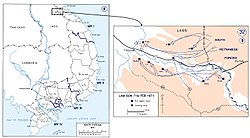Operation Lam Son 719
| Operation Lam Son 719 | |||||||
|---|---|---|---|---|---|---|---|
| Part of the Vietnam War | |||||||
 Map showing fire support bases and movement of forces |
|||||||
|
|||||||
| Belligerents | |||||||
|
|
|
||||||
| Commanders and leaders | |||||||
|
|
|
||||||
| Strength | |||||||
|
US Air Force |
~25,000 to ~35,000 troops | ||||||
| Casualties and losses | |||||||
|
1,149 wounded 38 missing Vehicles (US/ARVN): 32+ artillery pieces destroyed, 82 captured 168 helicopters destroyed, 618 damaged |
Source (South Vietnam): 13,345 killed |
||||||
South Vietnam partially disrupts the Ho Chi Minh Trail. They suffer heavy casualties in the withdrawal.
![]() Source 1 (U.S.): 1,529 killed
Source 1 (U.S.): 1,529 killed
5,483 wounded
625 missing
Source 2 (U.S.): 8,483 killed
12,420 wounded
691 missing
1,149 captured
Operation Lam Son 719 (Vietnamese: Chiến dịch Lam Sơn 719 or Chiến dịch đường 9 – Nam Lào) was a limited-objective offensive campaign conducted in the southeastern portion of the Kingdom of Laos. The campaign was carried out by the armed forces of the Republic of Vietnam (South Vietnam) between 8 February and 25 March 1971, during the Vietnam War. The United States provided logistical, aerial, and artillery support to the operation, but its ground forces were prohibited by law from entering Laotian territory. The objective of the campaign was the disruption of a possible future offensive by the People's Army of Vietnam (PAVN), whose logistical system within Laos was known as the Ho Chi Minh Trail (the Truong Son Road to North Vietnam).
By launching such a spoiling attack against PAVN's long-established logistical system, the American and South Vietnamese high commands hoped to resolve several pressing issues. A quick victory in Laos would bolster the morale and confidence of the Army of the Republic of Vietnam (ARVN), which was already high in the wake of the successful Cambodian Campaign of 1970. It would also serve as proof positive that South Vietnamese forces could defend their nation in the face of the continuing withdrawal of U.S. ground combat forces from the theater. The operation would be, therefore, a test of that policy and ARVN's capability to operate effectively by itself.
...
Wikipedia
